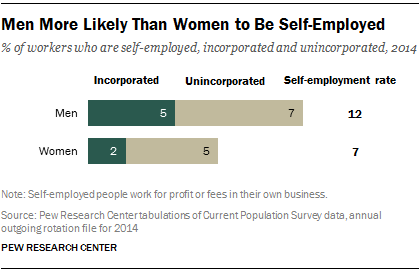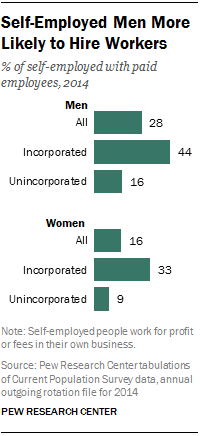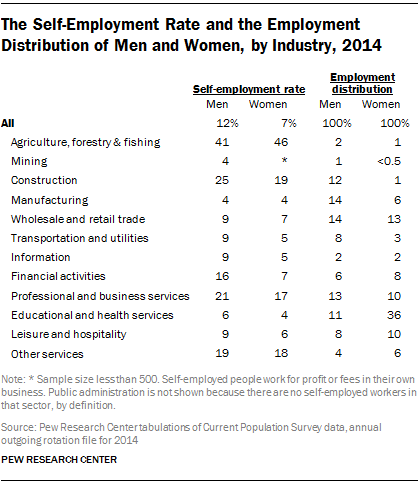 There is a large gender gap in self-employment and job creation. Men greatly outnumber women among the self-employed, they are more likely than women to have paid employees, and, when they hire workers, they typically hire more of them than women do. Thus, men account for the lion’s share of job creation by the nation’s self-employed workers.
There is a large gender gap in self-employment and job creation. Men greatly outnumber women among the self-employed, they are more likely than women to have paid employees, and, when they hire workers, they typically hire more of them than women do. Thus, men account for the lion’s share of job creation by the nation’s self-employed workers.
 Some 12% of male workers were self-employed in 2014, compared with 7% of women, and of the nation’s 14.6 million self-employed workers, 9.5 million were men and 5.1 million were women. Thus, in 2014, 65% of all self-employed workers were men and only 35% were women. The current disparity is in keeping with long-term trends in self-employment.18
Some 12% of male workers were self-employed in 2014, compared with 7% of women, and of the nation’s 14.6 million self-employed workers, 9.5 million were men and 5.1 million were women. Thus, in 2014, 65% of all self-employed workers were men and only 35% were women. The current disparity is in keeping with long-term trends in self-employment.18
The gender composition of self-employed workers contrasts sharply with the makeup of employment overall. In 2014, America’s 146.4 million workers consisted of 77.8 million men and 68.6 million women. Thus, men accounted for 53% of overall employment and women accounted for 47%.
Incorporated businesses represent the lesser of the two major types of businesses run by both men and women. Some 5% of all male workers operated incorporated businesses in 2014 and 7% had unincorporated businesses. Among female workers overall, only 2% owned incorporated businesses and 5% kept unincorporated businesses.
The Hiring of Other Workers by Self-Employed Men and Women
 The likelihood of employing paid workers varies markedly by gender. Self-employed men were nearly twice as likely as women to have at least one paid employee in 2014, 28% compared with 16%. In number, 2.6 million self-employed men and 803,000 self-employed women engaged other workers.
The likelihood of employing paid workers varies markedly by gender. Self-employed men were nearly twice as likely as women to have at least one paid employee in 2014, 28% compared with 16%. In number, 2.6 million self-employed men and 803,000 self-employed women engaged other workers.
Something self-employed men and women do have in common is that those with incorporated businesses are much more likely to hire than those with unincorporated business. Among self-employed men, 44% of those with incorporated firms had paid employees in 2014. Among self-employed women with incorporated firms, 33% had paid employees. Self-employed workers of either gender with unincorporated businesses hire at much lower rates—only 16% of men and 9% of women did some hiring.
More likely to be self-employed and more likely to have paid employees, self-employed men provided 23.3 million jobs in 2014, compared with 6.1 million jobs established by self-employed women. Most of these jobs flow from incorporated businesses—18 million in incorporated businesses owned by men and 4.4 million in incorporated businesses owned by women.
Self-employed men also run larger firms than self-employed women, judging by payroll numbers. Men with paid employees had an average of 8.8 workers in 2014, ranging from 5.6 among the unincorporated to 10.6 among the incorporated. Self-employed women with paid employees created 7.6 jobs on average, and women with incorporated businesses had an average of 9.1 employees.
Most self-employed men and women had far fewer employees, however. At the median, self-employed men with paid employees hired only four workers and self-employed women who hired had only three.
 The gender gap in self-employment and job creation is not fully understood, but two factors appear to play a role: family obligations and the distribution of men and women across industries. As noted, about four-in-ten self-employed women (38%), compared with 17% of men, reported working part-time for noneconomic reasons in 2012. This indicates that child care and other family matters, potentially in addition to school or training, diminish the time women may spend on running a business. It is estimated that self-employed women averaged 32.6 hours of work per week in 2012, compared with 40.3 hours for self-employed men.19
The gender gap in self-employment and job creation is not fully understood, but two factors appear to play a role: family obligations and the distribution of men and women across industries. As noted, about four-in-ten self-employed women (38%), compared with 17% of men, reported working part-time for noneconomic reasons in 2012. This indicates that child care and other family matters, potentially in addition to school or training, diminish the time women may spend on running a business. It is estimated that self-employed women averaged 32.6 hours of work per week in 2012, compared with 40.3 hours for self-employed men.19
The concentration of men and women in different industries also plays a role. In 2014, half of women who worked did so in just two industries: educational and health services (36%) and wholesale and retail trade (13%). Self-employment in these industries is modest, whether among men or women. Among those in educational and health services, only 6% of men and 4% of women were self-employed last year. In wholesale and retail trade, the self-employment rates for men and women were 9% and 7%, respectively.
Women, like men, had relatively high self-employment rates in four industries: agriculture, forestry and fishing (46% for women versus 41% for men), construction (19% versus 25%), professional and business services (17% versus 21%), and other services (18% versus 19%). But while 31% of men who work were employed in these sectors overall, only 18% of women with jobs were similarly situated. The major disparity was in construction, with 12% of employed men and 1% of women working in that industry in 2014.
In a related note, men and women were equally likely to be self-employed in the manufacturing sector, at 4% each. As reported, self-employed workers in manufacturing were the most likely to have paid employees—39% of them had at least one in 2014.20 But only 6% of women worked in manufacturing overall, compared with 14% of men.


